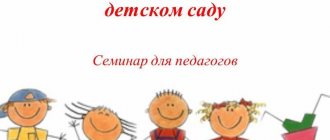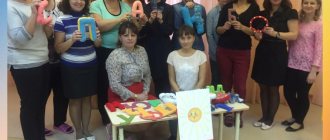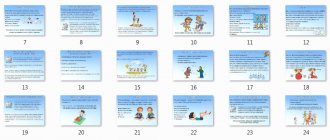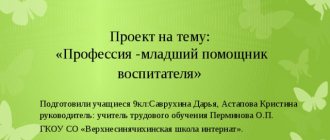Training for young teachers “My dream job”
Training for young teachers
"My dream job"
Target:
contribute to reducing adaptation problems and successful entry into the professional activity of a young teacher.
Tasks
:
1. Create conditions for overcoming the difficulties of beginning teachers in communication and interaction with children, teachers and parents.
2.Help teachers increase their self-confidence.
3.Provide practical assistance in building effective communication with participants in the educational process.
Methodological support:
pens for each participant, A4 sheets of paper according to the number of participants, white board, marker.
Event plan:
Progress of the training
Good afternoon, dear colleagues!
I am very pleased to see you at our school today. I look forward to your cooperation and active work.
Basic rules of communication
- It is not customary to offend or interrupt.
- Address each other by name, using “you” in the first person (for example: I want, I think, I feel...).
- Treat each other with respect.
- If a business starts, everyone without exception participates in it.
Exercise “Nobody knows that I...”
(everyone in the circle says the phrase “Nobody knows that I...” while passing the ball, then the phrase changes in the reverse order. “Everyone knows that I...”
“Dozens of young teachers worked with me
I became convinced that no matter how a person successfully
did not graduate from a pedagogical university, no matter how talented he was,
and if he does not learn from experience, he will never be a good teacher,
I myself studied with older teachers..."
A.S. Makarenko
The first years of work for a young specialist are the most difficult. In addition to the willingness to apply theoretical knowledge in practice, it is important for a teacher to be able to adapt to a team.
Adaptation of an employee is the adaptation of an individual to the workplace and work collective. Thus, when a new employee joins an organization, there is an adjustment process. Therefore, the adaptation process can be defined as the mutual adaptation of the employee to the organization, and the organization to the employee. And the possibility of long-term cooperation depends on how successful this adaptation is.
Professional adaptation is the adaptation of an employee to the work performed. It consists in familiarizing and actively mastering the profession, its intricacies, specifics, acquiring professional skills sufficient for high-quality performance of duties, in the formation of some professionally necessary personality qualities, in the development of a stable positive attitude of the employee towards his profession.
Unlocking the creative potential of a young teacher can be facilitated by awareness of the position they occupy in relation to children. There are several educational positions, each of which can manifest itself in its pure form, but there can also be combinations of different positions.
First position: Karabas-Barabas.
Karabas-Barabas needs obedient and skillful performers for his performances. To achieve his goals, he uses the following methods of influence: whip, shout, dictate, punishment, instruction. Karabas does not teach, but trains, achieving a certain success: the puppets master the set of knowledge, skills and abilities that are needed for Barabas’ performances.
Second position: Malvina
Malvina is a well-bred girl. She knows for sure that she should wash her hands before eating, brush her teeth, read books, etc. She truly believes that everyone should follow these rules. When the child’s behavior does not fit into the norms that she considers the only correct ones, Malvina puts the naughty baby in the closet. The position of the teacher - Malvina leads children to limited mental activity, reproduction of stereotypical ways of behavior and problem solving. This happens because Malvina offers herself to children as their only role model.
Third position: Little Red Riding Hood
Little Red Riding Hood is careless, hoping that everything will work out somehow. The position of the teacher - Little Red Riding Hood - leads children to difficulties in planning and predicting their own actions.
Fourth position: Sleeping beauty
The surrounding reality does not exist for her: she is either indifferent to it or perceives it as an obstacle to her dreams (daydreams). A teacher who takes the position of Sleeping Beauty is actually outside the situation of interacting with children. He leaves them to their own devices.
Fifth position: Hen
The mother hen loves her baby chicks. At first she sits them for a long time. Then he watches over them vigilantly, tirelessly looking after them, showing where and how to get worms and grains. She constantly worries about her offspring, cackling, calling the chicks under her wing, under her vigilant control. A teacher who has taken the position of a mother hen harms the mental development of children by constantly taking care of them and doing a lot for them. Children lose the desire to learn; they do not want to learn on their own or overcome difficulties.
Sixth position: Snow Queen
The goal of the Snow Queen is power over the world, and in particular over Kai. “The Snow Queen” skillfully educates her subordinates, children become obedient executors of someone else’s will, they have no desire to do anything of their own free will.
Seventh position: Mary Poppins
Mary Poppins is a very educated person, wonderful at telling different stories, well-educated and accurately aware of how to behave in different situations (both in fairy tales and in real ones). On the other hand, Mary Poppins understands children very well: she understands what they feel, think, want or don’t want, i.e. she knows the children from the inside. Educator - Mary Poppins pursues one single goal - the development of the child.
Each of the teachers present has his own position of education, but from what we heard, we can conclude: that the most optimal position for a teacher is position No. 7.
Exercise “My professional plans.”
Each participant, together with the group, has the opportunity to reflect on what he expects from his professional life, what his aspirations are, what values are significant to him.
You can start the procedure as follows:
"Past, present and future."
Each participant is asked to draw three circles on a piece of paper with colored pencils, symbolizing their professional past, present and future. Participants choose the location, size and color of the circles themselves in accordance with their feelings.
After completing the task, the group is invited to discuss the presented drawings.
Questions that may be asked:
What color is each circle?
What size?
How do the past, present and future relate to each other?
What is the connection between them?
How are the participants' drawings different? etc.
If the circles are connected to each other, then goals and dreams gradually flow from one another. If bright, light colors are used, this means dreams and goals in a positive, optimistic way.
7). Game "Gift" (5 min.)
Please write on paper 3 qualities for which the teacher’s children value, love, and respect. The presenter collects the notes and gives them to everyone, mixing them.
And now, please give the written qualities to the one to whom they are most suitable among those present. Thank you for your general and interesting work.
8). Relaxation “Old Town” (Appendix 4) (10-15 min.)
Working with your inner world, your experiences, is the most important work to restore and discover the body’s own resources. This is exactly the kind of work I am offering you now with the help of psychosynthesis.
The presenter reveals the meaning of the symbols used, and the participants independently analyze what each one accomplished.
9). Exercise: “Resource bag” (3 min.)
I would like you to always remember that each person has his own inner resource. He helps us to withstand difficult times, to find strength when it seems that nothing will work out.
Think for yourself: what could this be?
In order not to forget that this resource really exists, I have prepared a resource bag for you.
Let this talisman remind you of your inner human potential.
A bag of small beads and shells is passed around. Everyone takes turns taking a talisman out of the bag as a keepsake.
Lesson summary
.
(3 min.)
A “Feedback Sheet” is issued against the background of music.
Appendix No. 1
"Old city"
Please sit down more comfortably. Relax. Feel how your legs relax, feel how your stomach relaxes, feel how your arms relax, first your hands, then the relaxation rises up, your shoulders, neck, face, whole head relax. Feel how your whole body relaxes. Take a deep breath. Exhale, inhale again. Exhale. Inhale, exhale.
Now imagine a city, any city that first comes to your mind. Imagine what kind of streets it has - wide or narrow, long or short. Imagine what kind of houses - high multi-story buildings or small one-story ones, log or stone. What color are your houses? Imagine what time of year it is now in the city - spring, winter, summer or autumn... What is it morning, evening, day or night. Look around - are you alone in the city or are you surrounded by people. How many are there? What are they doing? How are they feeling? Do you want to do the same things they do? Listen, please, what do you hear? Birds singing, the sound of the wind, the creaking of a window, or is there silence around you? How do you feel in your city? Please remember this feeling.
Now let's take a walk around our city, along its streets. Each of you has your own city. For some it is large and wide, for others it is small. So we walk around the city and, having reached its very center, we find ourselves in the city square. Look at it carefully. What is she like? What shape? What size? There is a fountain in the center of the square. Let's get closer to it and take a look at it. Whether it works or not, whether it is big or small, round or square. Stand near him. How does it make you feel? What would you like to do now, standing near the fountain?
But suddenly, on the other side of the square, you notice a store. Let's go to him. The first thing that greets us is the display window. Let's take a closer look at it. What does it show? What is she like? Bright, colorful, catchy or simple, inconspicuous, one that does not catch the eye. Take a close look at the name of your store. Now let's go to the store.
Please take the door handle and pull the door towards you. Is it easy or difficult to open the door to the store? Come in. What awaits you inside? Look around. How do you like the store you came to? Do you feel good about it or not? Let's take a walk around it and see what's on sale. Please choose the item in the store that you like best. Look at it carefully. Why did you like it?
The lights in the store began to dim and you felt tired. You saw a chair in the corner of the store, come and sit in it. Feel how good you feel, stretch your legs. The light in the store becomes dim, and you are enveloped in twilight. In this twilight, different sounds begin to be heard. At first the sounds are quiet, barely audible, but the longer you sit, the louder they become. These are things talking to each other in a store. Please listen to what they may be talking about among themselves. You listen to the conversation, which flows calmly and quietly, and your eyelids become heavy. You fall asleep...
But suddenly you wake up. It's already dark outside the store window. You get up from your chair and leave the store. The store door closed behind you. A cold evening breeze blew over you. You open your eyes and find yourself here in our room.
Interpretation:
- The idea of a city and everything that is in it is how a person sees his life, how others see his life.
- The fountain is a person’s emotions, how he can express and control them
- A store window is how others see a person, how he can present himself.
- The door of a store is the entrance to the inner world (is it easy or difficult to open).
- The store (inside) is the inner world of a person.
- A thing is a human need.
Appendix No. 2
First position: Karabas-Barabas.
Karabas-Barabas needs obedient and skillful performers for his performances.
Second position: Malvina
Malvina is a well-bred girl. She knows for sure that she should wash her hands before eating, brush her teeth, read books, etc. She truly believes that everyone should follow these rules.
Third position: Little Red Riding Hood
Little Red Riding Hood is careless, hoping that everything will work out somehow.
Fourth position: Sleeping beauty
The surrounding reality does not exist for her: she is either indifferent to it or perceives it as an obstacle to her dreams (daydreams).
Fifth position: Hen
The mother hen loves her baby chicks. At first she sits them for a long time. Then he watches over them vigilantly, tirelessly looking after them, showing where and how to get worms and grains. She constantly worries about her offspring, cackling, calling the chicks under her wing, under her vigilant control.
Sixth position: Snow Queen
The goal of the Snow Queen is power over the world, and in particular over Kai.
Seventh position: Mary Poppins
Mary Poppins is a very educated person, wonderful at telling different stories, well-educated and accurately aware of how to behave in different situations (both in fairy tales and in real ones).
Where and how can seminars and workshops take place?
Seminars can be used as an effective means of training the teaching staff of a preschool institution and as a way to develop the creative abilities of employees. They can be held at a variety of levels - starting from the preschool educational institution itself and ending with large meetings at the district, regional or national level.
Typically, seminars held in kindergartens deal with more specific current topics or are related to the implementation of theory into practice, in particular, new legal requirements. If we are talking about seminars organized by specialized enterprises, then they may concern broader issues, for example, the socialization of students from different social strata of society or the psychological relief of preschool employees.
In some cases, you can take seminars for kindergarten teachers for free. On the Internet you can find sites with useful publications in this area, which can be used by teachers and kindergarten teachers as a basis for self-education and self-development.
Who needs seminars and workshops?
Since pedagogical science is constantly developing, new systems, methods and areas of work are being used, which practicing teachers and educators have to study and apply in their activities. This is necessary so that progress in the field of pedagogy does not remain only theoretical achievements, but has a direct impact on the practical process of education and training in preschool institutions.
That is why it is necessary for all kindergarten employees to take part in such seminars, regardless of their position and work experience. Even if a person has been working as a teacher for several decades, this does not mean that he does not need to improve himself and develop professionally. Often, for this category of preschool educational institution employees, such workshops are vitally important, since they underwent professional training a long time ago, at a time when the requirements for teaching and education were strikingly different from modern ones. Seminars will help them introduce best practices into their daily activities, making them modern, better and more advanced.
The seminar for beginning kindergarten teachers is equally important. Having just graduated from a secondary or higher pedagogical educational institution, they have a wealth of knowledge in their profession. But these are just theoretical calculations that they have yet to apply to real, real work with children. Therefore, seminars and workshops are a vital necessity for them. At them, novice educators and teachers learn to apply their knowledge for practical purposes, learn the intricacies of their profession, and become real employees of children's educational institutions.
The workshop will help you systematize the knowledge gained and transform it into special actions aimed at achieving your goal. This is an effective way of training and self-improvement for preschool teachers and educators.
Assignment of seminars and workshops

The seminar is an interactive form of training with a high level of efficiency. With its help, you can successfully solve numerous complex problems, as well as study the issue discussed at the seminar in depth and from all sides.
Any workshop workshop in kindergarten for teachers sets specific tasks and goals. It cannot have an abstract purpose, since it involves the implementation of specific knowledge and skills into practical use in preschool educational institutions.
The main objectives of the workshops are the following:
- Development of creative imagination and thinking.
- Improving knowledge and skills.
- Conducting discussions and debates.
- Creation and discussion of problem situations for their collective solution.
- Formation of competent recommendations.
In order for such a seminar not to be a mere mark of an event, its topic must be relevant specifically for a particular institution. For example, in a kindergarten where children with hearing disabilities are raised, an important topic for such a meeting may be the use of visual aids to develop in children associative connections between the name and the surrounding subject environment.
Also, the topic of the seminar should not be formal, that is, it involves solving specific issues. For example, if we are talking about implementing the requirements of the Federal State Educational Standard and the professional standard of preschool teachers, issues that are primarily interesting and not entirely clear to those gathered should be considered. The goal of the seminar should be to obtain practical knowledge on the topic used, which will allow them to be introduced into their daily practice in the work of the group and the entire kindergarten as a whole.





